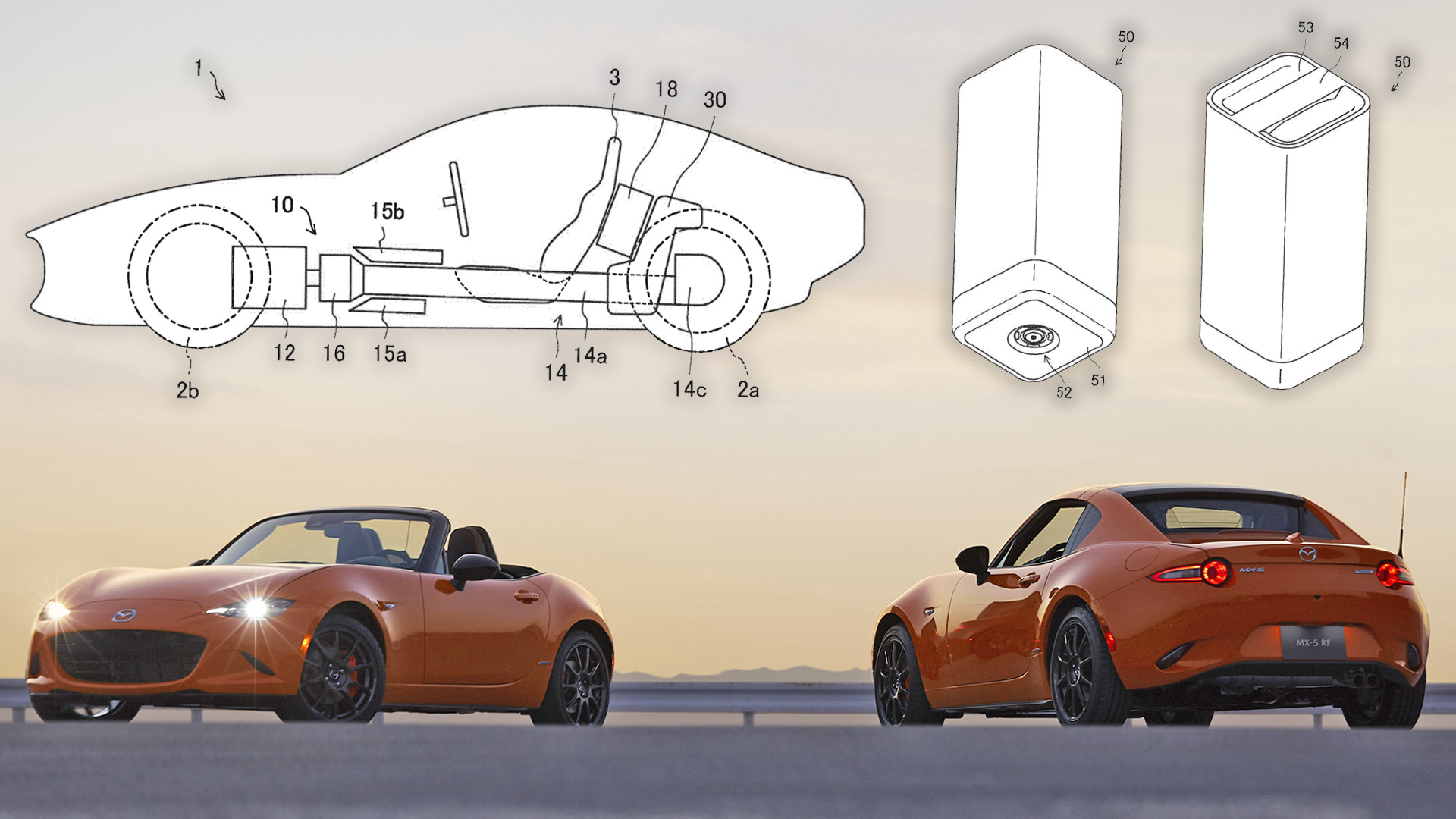

Mazda has been giving us a lot of information about a possible future hybrid sports car through documents filed with the United States Patent Office. At least one electrified roadster is very likely brewing at the automaker, and a recent patent granted to the Japanese company is particularly amazing. It details a hybrid drive system for a rotary-powered “one-row seat vehicle,” with a bank of swappable batteries located behind the driver. It’s a very interesting system that Mazda claims could boost range and keep the car lightweight.
The document itself goes back to June 2021, when it was first filed. Published a few days ago as a granted patent, it’s absolutely related to at least one previous doc that describes a similar system. This time, much more detail is provided.

The foundation of the system is a hybrid drivetrain with a rotary engine and three electric motors. If this sounds familiar, thanks for reading all of my Mazda patent posts! The main permanent magnet motor, mounted to the back of the engine, provides 25 kW (34 horsepower). It’s supplemented by two 17 kW (28 hp) induction motors, one for each front wheel. They’re driven by a bank of four battery modules, which are all under 60 volts. The old patent didn’t go into detail as to why they were a relatively low voltage for an automotive traction application, but it turns out my speculation back then was mostly right. The modules are meant to be handled safely not only by workers in the factory—60V of electrical potential is generally not enough to pass through the human—but by the end user.
Mazda’s document still insists on saying it’s “workers” who will be doing this but notes its system “makes battery replacement easy, and thus the problem of the cruising distance can be alleviated.” It’s doubtful it would be a “worker” doing this once the prospective car is sold unless you’re happy having a Mazda employee riding shotgun all the time. Might spoil the mood.
These modules would typically be wired in a 2P 2S configuration. In other words, two modules would be wired together in parallel and then connected in series. The parallel/series connections are completed with MOSFETs (electronically-controlled high-power switches), though, which makes the nominal voltage variable. The patent states anything from 48V to 96V could be provided.



This is still a relatively low voltage even for a hybrid car, but the document says that the inverter or other related power electronics would be capable of boosting this voltage in at least three stages. This means higher motor speeds could be achieved despite the battery being relatively diminutive. It’s worth noting that Toyota has done this on many of its hybrid systems for years. I even experimented with it on my homebrew go-kart. It works.
The relatively low module voltage is likely a consequence of their size and the fact they must be handled on a regular basis. With a limited amount of cells, it’s difficult to achieve high voltages without some help from something like a boost converter, which can increase the electrical potential at the cost of available current. Mazda says that two of these modules would remain in the car at all times, while the other two could be removed and replaced. So no, you won’t be able to make this thing a pure internal combustion roadster just by taking all of the batteries out.

As for the total battery capacity, Mazda doesn’t say much. A previous document claimed it was 3.7 kilowatt-hours, which would translate into a very achievable 925 watt-hours per module. In terms of weight, that depends on the type of cells used and what internal cooling might be present in the modules’ casing. The 2-kWh 48V module I used in my go-kart weighed around 26 pounds, so the Japanese automaker could be looking at a module weight of around 15 lbs for a total pack weight of roughly 60 lbs, but this is pure speculation.
In any case, this is an exciting system that would be a first in terms of user-swappable batteries. Mazda’s approach to hybrid cars has been anything but straightforward and this document describes an admittedly unorthodox system, but it really makes sense from the perspective of driving enjoyment.

I really want to hammer this home. Go off the rails with me for a second.
All permanent magnet electric motors deliver torque the same. That’s why almost all EVs have that sudden jolt of acceleration from a hit before it all falls off at high speeds. Hybrid cars are more dynamic than EVs because they mix electric juice and combustion power, but Mazda is going even further than that. It has two different types of electric motors in this one car. Both of them put down power in a different way. With what it’s describing here, it will be able to deliver a power curve more exciting and dynamic than any hybrid we’ve seen before. The way a vehicle like this could deliver power to the ground is unprecedented. It’s beyond interesting. If Mazda puts a vehicle with this system into production, it will be a driving experience like we’ve never experienced. That’s worth getting excited about.
Got a tip or question for the author? You can reach them here: peter@thedrive.com